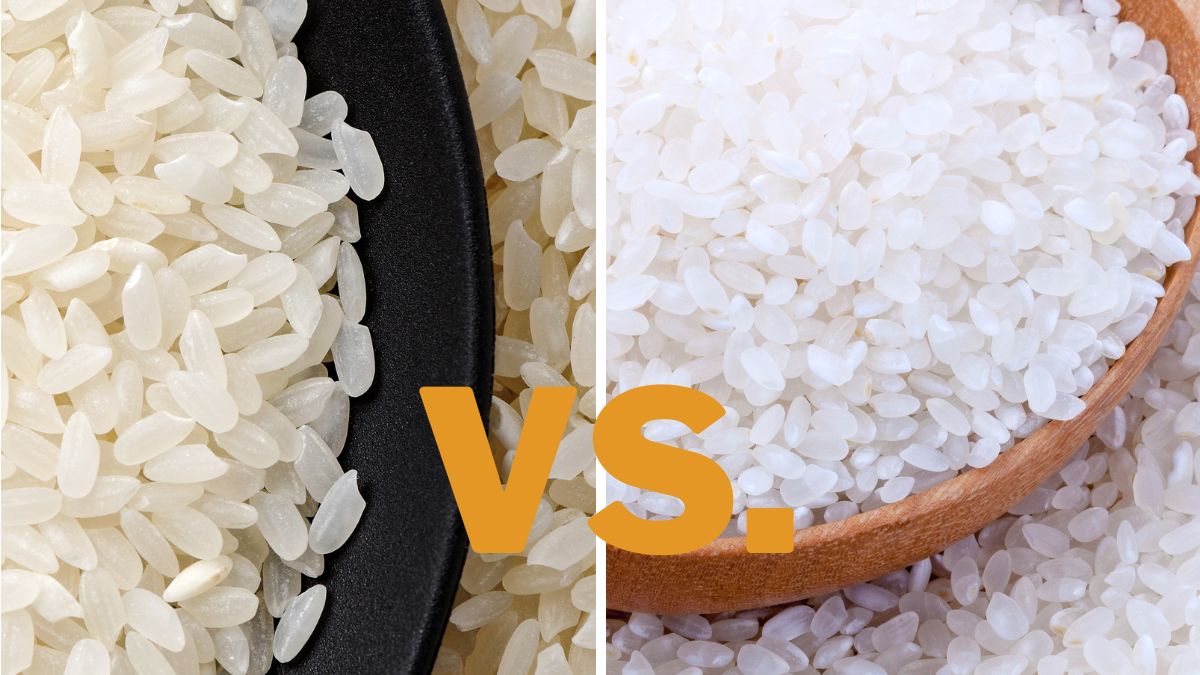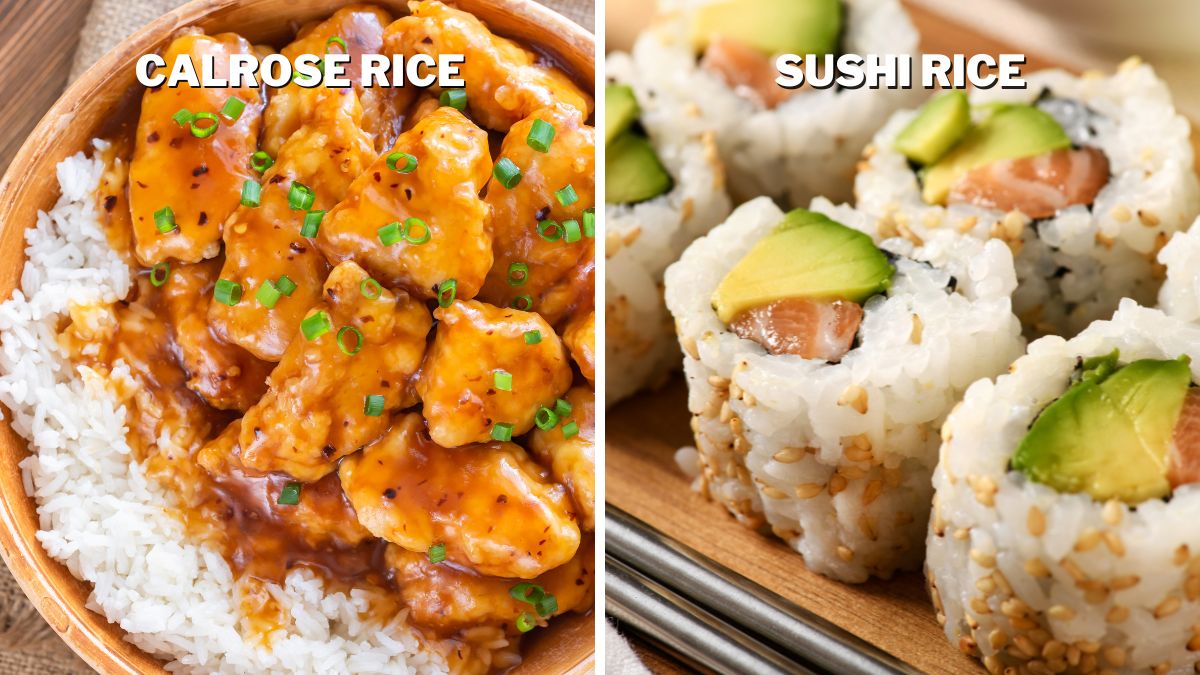Calrose Rice vs. Sushi Rice: Differences & Uses

Rice is one of the staples of Asian cuisine, and it comes in many different varieties. Two of the most popular types are Salrose rice and Sushi rice, but there are many similar types, and even I sometimes get confused in explaining the differences between each one. So, what is the difference between Calrose rice and Sushi rice?
Calrose is medium-grain, while Sushi is short-grain rice. While they are both sticky, Sushi rice has a more subtle flavor. Calrose rice is ideal for sticky dishes or ones with thick sauces like stir-fries, while Sushi rice is best used for making sushi rolls and other dishes without heavy sauces.
So if you ever find yourself stumped the next time someone asks the question, “What’s the difference between Calrose and Sushi rice?” I’ve got you covered. Hopefully, by the end of this article, you’ll better grasp why you should use each type for certain dishes, as well as what sets them apart. Let’s get started!
Are Calrose Rice and Sushi Rice Actually the Same?
Calrose is a type of medium-grain Japonica rice, which is a strain of Asian rice that’s native to Japan, China, and Korea. It has been cultivated in California since the 1950s and has been popular among sushi chefs as a go-to ingredient for sushi dishes.
Sushi rice, on the other hand, has a much longer history. Its origins go back to 4th century Japan, which was grown for the first time in the country. Today, Sushi rice is cultivated all over the world in warm climates. It is mainly grown in Japan, Taiwan, Thailand, and other Asian countries.
So, while Calrose was developed in America just over half a century ago, Sushi rice has been cultivated for centuries, making it much more popular with chefs looking to create authentic Japanese dishes.
While Calrose rice can be used to make Sushi, it differs from Sushi rice which has the ideal sushi sticky texture when boiled.
What Is the Difference Between Calrose Rice and Sushi Rice?
If you’re looking to make sushi at home, you may be wondering what type of rice is best to use. Calrose and Sushi rice are two types of Japanese rice, but it’s always best to use Sushi rice for sushi. Sushi rice is different than Calrose in a few key ways.
So, let’s have a look at them.
Grains Length
When it comes to the grains of Calrose rice and Sushi rice, there is a noticeable difference. Sushi rice is known for its sticky, short-grain quality, while Calrose is characterized by its medium-grain composition.
However, since Calrose rice is also known for its softness and stickiness, it can easily jump on and replace Sushi rice whenever needed. This stickiness is an important part of making sushi, as it helps the ingredients to stay together when rolling the sushi up.
Taste
Calrose rice usually has an earthy, well-balanced, or slightly sweet flavor. It’s known for its stickiness, which helps it bind well with other ingredients and retain its shape once cooked.
Sushi rice is much less sweet than Calrose rice – it has a more subtle flavor and smoother texture, achieved with the addition of vinegar or other seasonings. This difference in taste is why it’s considered ideal for sushi making.
The lower amylose content makes the flavor milder and more savory, making it the perfect bed for other flavors like spicy mayo or pickled ginger. Due to its specific texture, Sushi rice is also less likely to break apart when cooked.
Ultimately, the flavor of each grain stands out depending on what you add to it – for example, if you season your Calrose rice with something like teriyaki sauce, it’ll get a richer, fuller flavor.
Uses
There are notable differences when it comes to the best use of Calrose and Sushi rice. Generally, Calrose rice is best suited for dishes that require more stickiness, such as stir-fries or dishes with thick sauces. In contrast, Sushi rice is better suited for dishes that aren’t too saucy and need less stickiness, like sushi rolls, salads, snacks, and side dishes.
To get a balance between the two kinds of rice, I sometimes combine them simply by mixing both Calrose and Sushi rice together. This gives a dish an interesting texture and flavor.
Calrose rice is often used for dishes like salads and casseroles. Plus, its medium-sized grain makes it easier to eat with chopsticks, as well as helps it stick together better when rolled in a nori sheet.
Sushi rice is a variety of short-grain rice specifically grown and prepared for making sushi. Its higher starch content makes it stickier and sweeter than other types of rice, making it the perfect choice for dishes like sushi, ochazuke, and chirashizushi.

Cooking Considerations
When cooking with either Calrose or Sushi rice, there are a few key things to consider. First and foremost is the amount of water you use. For Calrose rice, you want to use about one and a half times the amount of water that you have rice. So, for example, for one cup of Calrose rice, you would use 1 1/2 cups of water.
Conversely, when using Sushi or short-grain rice, you will want to use a bit less water – about one cup for every three-quarters of a cup of Sushi rice. The rationale behind this is that because the grains are much smaller and more sticky than those in Calrose rice, they require less water in order to cook properly.
Besides, when cooking Sushi rice, you can also add a mixture of salt, sugar, and vinegar to the water and cook it perfectly.
Another thing to consider when using either type of rice is the cooking time. As expected, short-grain Sushi rice requires less cooking time (around 10 minutes) than Calrose (which takes around 20 minutes). Remember that overcooking either type of rice can lead to undesirable textures and flavors, so it’s best to monitor both types closely while on the stovetop.
